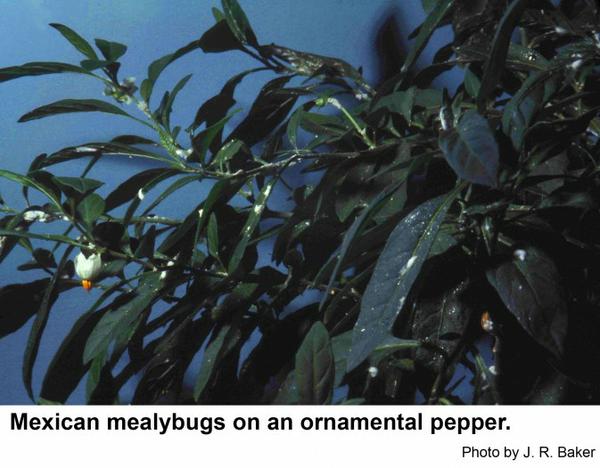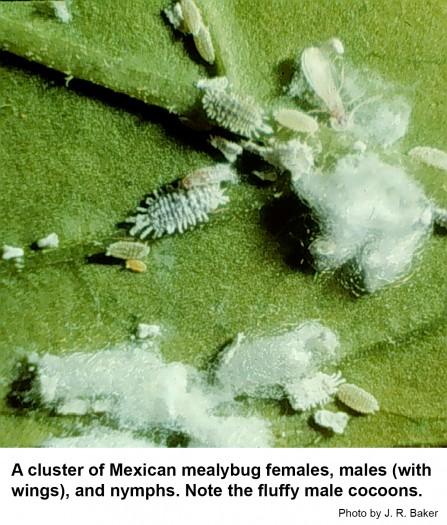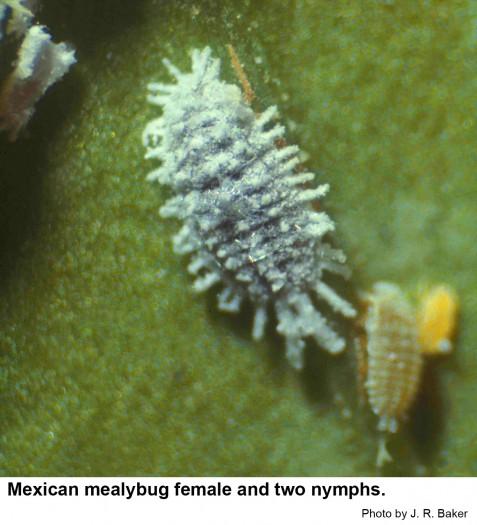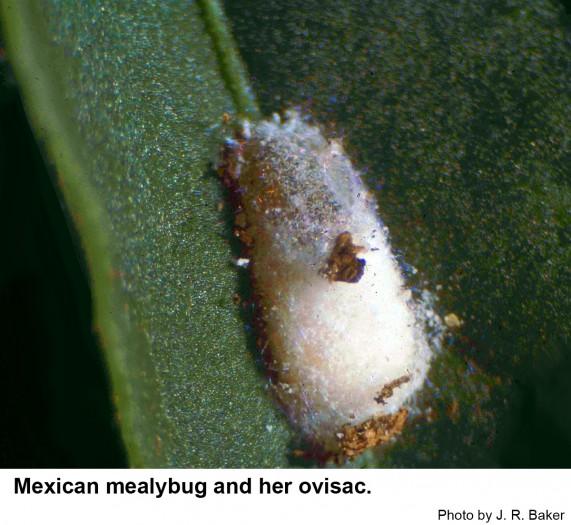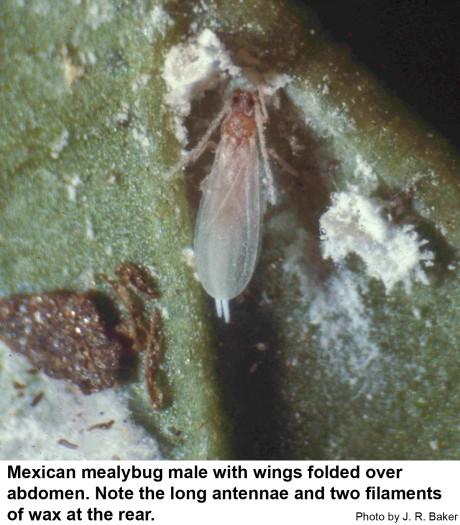Description and Biology
Female Mexican mealybugs, Phenacoccus gossypii, are almost 3/16 inch long, oval, grayish and covered with a thin, white, waxy secretion. They have three parallel rows of small waxy tufts down the back. This insect is a short-tailed mealybug (the tail filaments do not exceed 1/4 the body length). The lateral filaments are also short. Males are tiny gnatlike insects with two wings, four eyes, and long, waxy filaments at the rear that look like white tails. The ovisac (egg sac) is white, dense, narrow, and eventually longer than the female producing it. Females lay up to 400 eggs. The eggs hatch in 6 to 14 days. Nymphs are small, yellowish, and have white waxy secretions that eventually resemble those of adults. Males have only two nymph stages and then a prepupal and pupal stage. They generally fly after dark. Females have three nymph stages. Under greenhouse conditions, development from egg to adult female takes about 47 days.
Host Plants
The Mexican mealybug is found commonly on numerous ornamental plants, a few of which are Aralia, chrysanthemum, English ivy, geranium, Gynura, hollyhock, Ixia, lantana, and poinsettia. This insect is also a minor pest of lima beans in the warmer parts of the United States. Although not as severly damaging as citurs mealybugs, heavily infested plants eventually become wilted, stunted, and dark with sooty molds that grow in honeydew excreted by the mealybugs. The mealybugs themselves as well as their ovisacs also disfigure infested plants.
Residential Recommendation
Mealybugs are not easy to control. If only a few plants are infested and the number of mealybugs is low, mealybugs can be removed with a cotton swab dipped in rubbing alcohol. The plant can then be washed with a mild soapy water to remove residual wax and honeydew left by the mealybugs (about 2% soap, not detergent). The plants must be observed closely for a few weeks and new mealybugs removed as they appear. Soaps labeled for use as insecticides for mealybug control on ornamental plants include Safer's, Citrusoap, and Olympic brands. These soaps are available from garden shops and plant centers. Insecticidal soaps are popular with some horticulturists because of their relative safety to people. Houseplant sprays and granular treatments are also available for home use. If labeled for mealybugs, they should give adequate control. Mealybug ovisacs complicate control measures because pesticides do not readily penetrate into the ovisac to kill the eggs. Consequently, plants infested with mealybugs probably should be treated at weekly intervals at least twice and probably three times for complete control. This allows time for the eggs to hatch and the new mealybugs to emerge from the ovisacs. Orthene and imidacloprid are systemic insecticides that can be used for mealybug control by homeowners. With Orthene, it would be a good idea to treat plants outdoors as Orthene has a distinct odor some find offensive.
References
- Insect and related Pests of Flowers and Foliage Plants. Baker, J. R., ed. 1994. North Carolina Cooperative Extension Service Publication AG-136. 106 pp.
- Mealybugs. Frank, S. D. 2010. Entomology Insect Notes, NC State Extension Publications.
- Mealybugs of California, with taxonomy, biology, and control of North American species (Homoptera: Coccoidea: Pseudococcidae). McKenzie, H. H. 1967. Univ. California Press. Berkely and Los Angeles. 525 pp.
- Extension Plant Pathology Publications and Factsheets
- Horticultural Science Publications
- North Carolina Agricultural Chemicals Manual
For assistance with a specific problem, contact your local N.C. Cooperative Extension Center.
This Factsheet has not been peer reviewed.
Publication date: Nov. 4, 2013
Reviewed/Revised: Oct. 27, 2023
Recommendations for the use of agricultural chemicals are included in this publication as a convenience to the reader. The use of brand names and any mention or listing of commercial products or services in this publication does not imply endorsement by NC State University or N.C. A&T State University nor discrimination against similar products or services not mentioned. Individuals who use agricultural chemicals are responsible for ensuring that the intended use complies with current regulations and conforms to the product label. Be sure to obtain current information about usage regulations and examine a current product label before applying any chemical. For assistance, contact your local N.C. Cooperative Extension county center.
N.C. Cooperative Extension prohibits discrimination and harassment regardless of age, color, disability, family and marital status, gender identity, national origin, political beliefs, race, religion, sex (including pregnancy), sexual orientation and veteran status.

